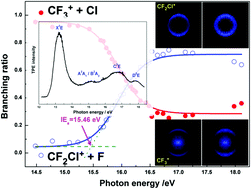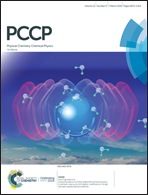Dissociative photoionization of CF3Cl via the C2E and D2E states: competition of the C–F and C–Cl bond cleavages
Abstract
The dissociative photoionization of CF3Cl was investigated using threshold photoelectron photoion coincidence (TPEPICO) imaging in the energy range of 12.30–18.50 eV. The coincident time-of-flight mass spectra and three-dimensional time-sliced images of the CF2Cl+ fragment were recorded at a few specific photon energies. Two fragmentation pathways were observed that led to the breakage of the C–Cl and C–F bonds, while the branching ratio elicited an energy-dependent relationship. The CF3+ fragment was dominant in the dissociation of the X2E, A2A′ and B2A′′ states, while CF2Cl+ became the predominant fragment and its branching ratio remained constant in the energy range associated with the C2E and D2E states. Based on the inflection point in the energy-dependent curve of the fragment branching ratios, the adiabatic ionization energy (IEa) of C2E is suggested to be 15.46 eV. Although the excess energy increased considerably from C2E to D2E, the kinetic energy release distributions (KERDs) of CF2Cl+ were similar. Moreover, the anisotropy parameters β for the F-loss channel were positive and larger than those for the Cl-loss channel. The calculated F-loss potential energy curves of CF3Cl+ suggested that for the C2E and D2E states, the C–F bond rupture occurred via the internal conversion to the A2A′ state followed by the dissociation attributed to the crossing of the barrier along the C–F coordinate. Based on the experimental and theoretical conclusions, the internal conversion is the rate-determining step in the dissociative photoionization of CF3Cl via the C2E and D2E ionic states, irrespective of whether the C–F and C–Cl bonds rupture.



 Please wait while we load your content...
Please wait while we load your content...